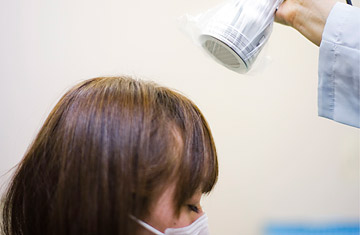
A woman in Yonezawa waits to learn if she has absorbed radiation and if so, how much
(4 of 4)
What harm any radiation causes depends on which elements are involved in the exposure. There are four kinds of isotopes that are the likeliest, from a public-health perspective, to be a danger if emitted by a nuclear power plant: iodine-131, cesium-137, strontium-90 and plutonium-239. Exposure to iodine-131 can lead to cancer — specifically thyroid cancer — and it can happen comparatively fast. Epidemiologists estimate that after the Chernobyl explosion, there were 6,000 to 7,000 cases of thyroid cancer that would not otherwise have occurred.
Strontium and cesium are not nearly so selective. "Strontium gets incorporated into bones and teeth," says Helfand, "and can stay there, irradiating the body for a long time." Strontium is most commonly linked to leukemia. Cesium behaves more like potassium when it's inside the body, which means it circulates everywhere. It doesn't linger as long as strontium does, but it stays long enough to cause cancer of the liver, kidneys, pancreas and more. Most toxic of all is plutonium, which is typically inhaled and likeliest to lead to lung cancer.
Not surprisingly, fears of such outcomes have led to overreaction. In the same way people stocked up on the antibiotic Cipro during the anthrax attacks of 2001, so they are now buying iodine pills. That's indeed a hedge against thyroid cancer, since there is a limit to how much of any type of iodine the body can absorb. Filling up on the nonradioactive kind shuts out the kind a power plant emits. But taking iodine can be dangerous if you don't know the right dose, and it's just silly to bother until you have a real sense of what the danger is.
Workers at the Fukushima plant, of course, are more at risk than the rest of us. On March 16, the radiation level between two reactor buildings was measured at 400 mSv per hour, a dose equivalent to undergoing 2,000 chest X-rays in the same period, according to the International Atomic Energy Agency. There have been no reports of what the levels have become if Coolant Pool 4 is indeed dry. The Japanese authorities are not revealing much about how they're protecting the workers. They are surely wearing full bodysuits that protect them from particles and carrying dosimeters that let them know when they've reached a dangerous dose of radiation. The work is not a death sentence, but for some of them, it might be close.
"The helicopter pilots who dumped sand on the burning core at Chernobyl knew they were going to die, and they did die," says Shan Nair, a British nuclear-safety expert who was part of a panel that advised the European Commission on its response to that disaster. "We don't know what the radiation levels are inside the plant. Reports of a 400-mSv figure suggest that it's not a suicide mission, [but] it is still a risky operation." Bergeron disagrees. "I think some of them will be sacrificed," he says. "These are heroic actions, but it's going to be a real challenge to keep some of these people alive."
As the fuel rods inside the ruined plant cool — assuming they do — tempers and panic will follow suit. It's a hard truth that we have tied ourselves to nuclear power for years to come. In the short term, higher seawalls and more prudently placed diesels will help prevent a repeat of the current emergency. Future nuclear plants can include what are known as passive safety systems. Reactors could be immersed in water at all times, for example. In the event of an accident, the vessel could be opened to allow coolant to circulate on its own. The rub is cost. Passive controls and other modifications like sturdier design are expensive, and the only way the nuclear industry can compete with coal and oil is to not include too many bells and whistles — like extra safety systems — on reactors. One answer, of course, is to tax carbon, raising its cost to make alternatives such as wind and solar power competitive with fossil fuels, thus obviating the need for so much nuclear power.
But that possibility brings the discussion full circle to an argument that seems to flare up every time there's a Three Mile Island or a blown BP oil well or a group of 33 Chilean miners who get trapped underground. And it's an argument we'll keep having until the species that was clever enough to tame fire, harness steam and pry unthinkable power from a lump of uranium ore becomes smart enough to take the next step forward.
-- with reporting by Eben Harrell / London, Bill Powell / Tokyo, Bryan Walsh / New York
